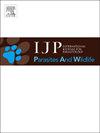中国内蒙古沙漠啮齿动物体表寄生跳蚤的宿主选择及其影响因素
IF 2
3区 医学
Q3 ECOLOGY
International Journal for Parasitology-Parasites and Wildlife
Pub Date : 2024-09-21
DOI:10.1016/j.ijppaw.2024.100993
引用次数: 0
摘要
跳蚤经常寄生在啮齿动物身上,是许多人畜共患病的主要传播媒介。中国内蒙古的阿拉善沙漠是亚洲典型的干旱地区,适合多种啮齿类动物在此环境中共存。了解跳蚤在这些啮齿类动物中的宿主选择及其影响因素,对于理解鼠传疾病和跳蚤的媒介作用至关重要。本研究利用活体诱捕法捕捉了 2022 年 4 月至 10 月期间在阿拉善沙漠共存的啮齿动物。研究人员收集了体表跳蚤,并分析了不同宿主、性别和繁殖状态下跳蚤的数量。结果表明(1) 寄生在不同啮齿类动物身上的跳蚤种类和数量存在显著差异,Ophthalmopsylla kiritschenkoi和Mesopsylla hebes喜欢以Dipus sagitta和Orientallactaga sibirica为宿主,Xenopsylla conformis喜欢以Meriones meridianus为宿主。(2)跳蚤对宿主有性别偏好选择,更偏好雄性宿主。(3)在不同生殖状态的啮齿类动物中,大多数跳蚤喜欢寄生在非生殖期的个体身上。(4)跳蚤的平均数量在不同季节有显著差异(P < 0.05),春秋两季是跳蚤寄生的高峰期。(5)影响跳蚤平均数量的因素包括寄主种类、性别、繁殖状况和季节,其中影响最大的是寄主种类。本文章由计算机程序翻译,如有差异,请以英文原文为准。

Host selection and influencing factors of parasitic fleas on the body surface of desert rodents, Inner Mongolia, China
Fleas frequently parasitize rodents and serve as major vectors for many zoonotic diseases. The Alxa Desert in Inner Mongolia, China, is a typical arid region in Asia, which is suitable for the coexistence of a variety of rodents in this environment. Understanding the host selection of fleas among these rodents and the factors influencing this selection is crucial for comprehending rodent-borne diseases and the vector roles of fleas. This study utilized live-trap methods to capture rodents coexisting in the Alxa Desert from April to October 2022. Body surface fleas were collected and analyzed for abundance across different hosts, sexes, and reproductive statuses. The results indicated that: (1) there were significant differences in the species and abundance of parasitic fleas on different rodent species, with Ophthalmopsylla kiritschenkoi and Mesopsylla hebes preferring the Dipus sagitta and Orientallactaga sibirica as their hosts, and Xenopsylla conformis preferring Meriones meridianus as its host. (2) Fleas exhibited sex-preferential host selection, showing a greater preference for male hosts. (3) Among rodents of different reproductive states, most fleas prefer to parasitize individuals in non-reproductive periods. (4) The mean abundance of fleas varied significantly between seasons (P < 0.05), with spring and autumn being the peak periods for flea parasitism. (5) Factors influencing the mean abundance of fleas included host species, sex, reproductive status, and season, with host species having the greatest impact.
求助全文
通过发布文献求助,成功后即可免费获取论文全文。
去求助
来源期刊

International Journal for Parasitology-Parasites and Wildlife
Medicine-Infectious Diseases
CiteScore
3.80
自引率
5.60%
发文量
113
审稿时长
45 days
期刊介绍:
The International Journal for Parasitology: Parasites and Wildlife (IJP-PAW) publishes the results of original research on parasites of all wildlife, invertebrate and vertebrate. This includes free-ranging, wild populations, as well as captive wildlife, semi-domesticated species (e.g. reindeer) and farmed populations of recently domesticated or wild-captured species (e.g. cultured fishes). Articles on all aspects of wildlife parasitology are welcomed including taxonomy, biodiversity and distribution, ecology and epidemiology, population biology and host-parasite relationships. The impact of parasites on the health and conservation of wildlife is seen as an important area covered by the journal especially the potential role of environmental factors, for example climate. Also important to the journal is ''one health'' and the nature of interactions between wildlife, people and domestic animals, including disease emergence and zoonoses.
 求助内容:
求助内容: 应助结果提醒方式:
应助结果提醒方式:


